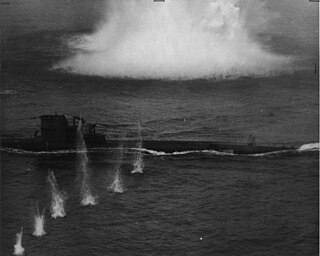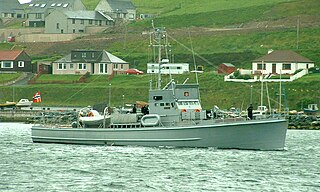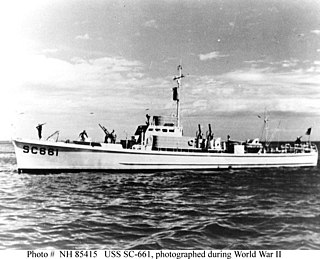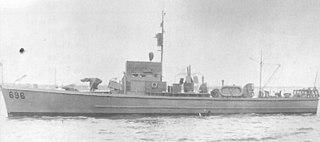USS SC-744 was an SC-497-Class submarine chaser of the United States Navy during World War II. She was sunk by a Japanese Kamikaze in 1944. [1]
USS SC-744 was an SC-497-Class submarine chaser of the United States Navy during World War II. She was sunk by a Japanese Kamikaze in 1944. [1]
SC-744 was ordered and laid down in Quincy, Massachusetts on 16 and 18 February 1942. [2] By May, she was launched, and then commissioned as PC-744 in July. In April 1943, she was re-designated as SC-744. She was assigned to the Task Force 70.1, U.S. 7th Fleet in the Pacific Theatre.
At 0713 hours, SC-744 got underway from San Pedro Bay, Philippines to escort a ship and high octane gasoline barge to Liloan, Philippines. She cleared the harbor at 0829 hours. [3]
At 1130 hours, she intercepted a distress call from the USS Mount McKinley stating she was under heavy air attack. The officer of the deck witnessed anti-aircraft fire and explosions eight miles off the port quarter. The ship immediately went to general quarters. The engines were brought to 12 knots and she began "zig zagging" in front of the convoy as evasive action. At 1157 hours, a Mitsubishi A6M Zero out-turned a Lockheed P-38 Lightning and began an attack run on the vessel. At that point the crew began 40mm, 20mm, and 12.7mm anti-aircraft fire. [4] The Captain ordered left rudder and the Zero opened fire at 1500 yards away. At 500 yards, the plane dropped a small bomb which exploded in the water. Shortly after the plane, damaged by gunfire, slammed into the stern of the ship on the port side near the galley hatch. The explosion wounded six men and killed another. The Zero was completely destroyed and the pilot killed.
USS SC-749 arrived at the scene at 1430 hours after the crew set off red smoke pots lent from another assisting vessel. At 1700 hours, she was taken into tow and arrived at Tacloban, Philippines. She sunk while moored on 30 November 1944 while undergoing salvage operations in four fathoms of water. [5]
She was struck from the Navy List on 19 January 1945.
SC-744 received one battle star for her service.

USS Underhill (DE-682) was a Buckley-class destroyer escort of the United States Navy during World War II. Built in 1943, she served in the Atlantic, the Mediterranean, and the Pacific until her sinking in a suicide attack by a Japanese Kaiten manned torpedo on 24 July 1945.

USS Dorado (SS-248), a Gato-class submarine, was the first submarine of the United States Navy to be named for the dorado.

USS Albacore (SS-218) was a Gato-class submarine which served in the Pacific Theater of Operations during World War II, winning the Presidential Unit Citation and nine battle stars for her service. During the war, she was credited with sinking 13 Japanese ships and damaging another five; not all of these credits were confirmed by postwar Joint Army–Navy Assessment Committee (JANAC) accounting. She also holds the distinction of sinking the highest warship tonnage of any U.S. submarine. She was lost in 1944, probably sunk by a mine off northern Hokkaidō on 7 November.
German submarine U-219 was a Type XB submarine of Nazi Germany's Kriegsmarine during World War II. The U-boat was laid down on 31 May 1941 at the Germaniawerft yard at Kiel as yard number 625, launched on 6 October 1942, and commissioned on 12 December 1942 under the command of Korvettenkapitän Walter Burghagen.
German submarine U-333 was a Type VIIC U-boat of Nazi Germany's Kriegsmarine during World War II. The submarine was laid down on 11 March 1940 at the Nordseewerke yard at Emden, launched on 14 June 1941, and commissioned on 25 August 1941 under the command of Kapitänleutnant Peter-Erich Cremer. After training with the 5th U-boat Flotilla at Kiel, on 1 January 1942 U-333 was transferred to the 3rd U-boat Flotilla based at La Pallice for front-line service.

The Japanese aircraft carrier Unryū was the lead ship of her class of fleet aircraft carriers built for the Imperial Japanese Navy (IJN) during World War II. She was commissioned in mid-1944, but fuel and aircrew shortages limited her use to Japanese waters. The impending American invasion of Luzon caused the IJN to order her to transport aircraft and supplies to the Philippines in December. The ship was torpedoed and sunk by the American submarine USS Redfish in the East China Sea during the voyage.

German submarine U-134 was a Type VIIC U-boat of Nazi Germany's Kriegsmarine during World War II. She was laid down on 6 September 1940 by Bremer Vulkan in Bremen-Vegesack as yard number 13 and commissioned on 26 July 1941. In seven patrols, U-134 sank three ships for a total of 12,147 gross register tons (GRT).

HNoMS Hitra is a Royal Norwegian Navy submarine chaser that saw action during World War II. She is named after the Norwegian island of Hitra.
USS PC-1129 was a PC-461-class submarine chaser built for the United States Navy during World War II. She was sunk by a Japanese suicide boat in January 1945 in the South China Sea.

The SC-497-class submarine chasers were a class of 438 submarine chasers built primarily for the United States Navy from 1941–1944. The SC-497s were based on the experimental submarine chaser, USS SC-453. Submarine chasers of this variety were collectively nicknamed "the splinter fleet" due to their wooden hulls.
The Torpedo Alley, or Torpedo Junction, off North Carolina, is one of the graveyards of the Atlantic Ocean, named for the high number of attacks on Allied shipping by German U-boats in World War II. Almost 400 ships were sunk, mostly during the Second Happy Time in 1942, and over 5,000 people were killed, many of whom were civilians and merchant sailors. Torpedo Alley encompassed the area surrounding the Outer Banks, including Cape Lookout and Cape Hatteras.

The HNoMS Vigra was a Royal Norwegian Navy submarine chaser that saw action during World War II. She was named after the Norwegian island of Vigra.

The HNoMS Hessa was a Royal Norwegian Navy submarine chaser that saw action during World War II. She was named after the Norwegian island of Hessa.
HMS Goodall (K479) was a British Captain-class frigate of the Royal Navy in commission during World War II. Originally constructed as the United States Navy Evarts-class destroyer escort USS Reybold (DE-275), she served in the Royal Navy from 1943 until her sinking in 1945.

The USS PC-598 was a 173ft metal hulled PC-461-class submarine chaser in the United States Navy. The submarine chaser fought in the Pacific Theatre during World War II, and was converted to an amphibious landing control vessel during the war, reclassified as a Patrol Craft-Control (PCC). It participated in six amphibious invasions as a control vessel during the war.

Submarine warfare in the Black Sea in World War II during 1944 involved engagements between submarines of the Soviet Black Sea Fleet attacking Axis merchantmen, defended by Romanian and German naval warships, as well as German U-boats and Romanian submarines attacking Soviet merchants on the eastern Black Sea. Before the conclusion of the campaign, Romania joined the Allies after King Michael's Coup. These engagements were a part of the naval Black Sea campaigns.

USS SC-696 was an SC-497-Class Submarine chaser of the United States Navy during World War II. She was sunk on 23 August 1943 by German dive bombers.

HMS Nymphe was one of 20 Acorn-class destroyers built for the Royal Navy that served in the First World War. The Acorn class were smaller than the preceding Beagle class but oil-fired and better armed. Launched in 1911, the ship served with the 2nd Destroyer Flotilla, joining the Grand Fleet at the start of the war in 1914, and was transferred to Portsmouth in early 1916. She joined the 5th Destroyer Flotilla in the Mediterranean in 1918. She was placed in reserve in 1919 and was sold in 1921 to be broken up.